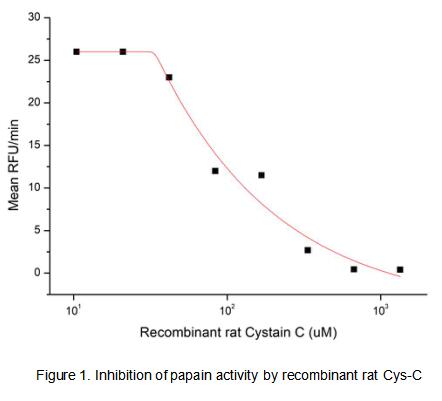Active Cystatin C (Cys-C)
CST3; Cystatin 3; Gamma Trace; Post-Gamma-Globulin; Neuroendocrine Basic Polypeptide; Amyloid Angiopathy And Cerebral Hemorrhage
- Product No.APA896Ra61
- Organism SpeciesRattus norvegicus (Rat) Same name, Different species.
- Buffer FormulationPBS, pH7.4, containing 5% Trehalose.
- TraitsFreeze-dried powder
- Purity> 90%
- Isoelectric Point9.2
- ApplicationsCell culture; Activity Assays.
- Download Instruction Manual
- UOM 10µg50µg 200µg 1mg 5mg
-
FOB
US$ 372
For more details, please contact local distributors!US$ 930
For more details, please contact local distributors! US$ 1860
For more details, please contact local distributors! US$ 5580
For more details, please contact local distributors! US$ 13950
For more details, please contact local distributors!
ACTIVITY TEST of the Active Cystatin C (Cys-C)

Cystatin C is a member of family 2 of the Cystatin superfamily. It is involved in processes such as tumor invasion and metastasis, inflammation and some neurological diseases. It inhibits many cysteine proteases such as papain and cathepsins B, H, K, L and S. It is ubiquitous in human tissues and body fluids. A point mutation in the gene coding for the 120 amino acid mature Cystatin C causes a hereditary form of amyloid angiopathy in which the protein variant (Leu68 to Gln) is deposited in the cerebral arteries, leading to fatal cerebral hemorrhage. Cystatin C may have additional clinical applications. For example, it is a good marker for glomerular filtration rate. The activity of recombinant rat Cystatin C was measured by its ability to inhibit papain cleavage of a fluorogenic peptide substrate Z-FR-AMC in the assay buffer 50 mM Tris, pH 7.0. Papain was diluted to 500 ug/ml in activation buffer 50 mM Tris, 5 mM DTT, pH 7.0 and incubated at room temperature for 15 minutes. The activated papain was diluted to 100 ug/ml in the assay buffer and 20 ul different concentrations of recombinant rat Cystatin C (MW: 14.93 KD) was incubated with 20 ul 100 ug/ml papain at 37 ℃ for 10 minutes. Loading 50 µL of the incubated mixtures which were diluted five-fold in assay buffer into empty wells of a plate, and start the reaction by adding 50 µL of 200 µM substrate. Include a substrate blank containing 50 µL of assay buffer and 50 µL of 200 µM substrate. Then read at excitiation and emission wavelengths of 380 nm and 460 nm, respectively, in kinetic mode for 5 minutes. The result was shown in Figure 1 and it was obvious that recombinant rat Cystatin C significantly decreased papain activity. The inhibition IC50 was <80 nM.
USAGE of the Active Cystatin C (Cys-C)
Reconstitute in 10mM PBS (pH7.4) to a concentration of 0.1-1.0 mg/mL. Do not vortex.
STORAGE of the Active Cystatin C (Cys-C)
Avoid repeated freeze/thaw cycles. Store at 2-8°C for one month. Aliquot and store at -80°C for 12 months.
STABILITY of the Active Cystatin C (Cys-C)
The thermal stability is described by the loss rate. The loss rate was determined by accelerated thermal degradation test, that is, incubate the protein at 37°C for 48h, and no obvious degradation and precipitation were observed. The loss rate is less than 5% within the expiration date under appropriate storage condition.
INCREMENT SERVICES
BCA Protein Quantification Kit
Molecular Mass Marker for Protein
Monoclonal Antibody Customized Service
Polyclonal Antibody Customized Service
Protein Activity Test Experiment Service
Electrophoretic Mobility Shift Assay (EMSA) Experiment Service
Buffer
Lentivirus Packaging Experiment Service
Adenovirus Packaging Experiment Service
Real Time PCR Experimental Service
Spike RBD Protein (S-RBD)
Protein G
Protein A
Related products
| Catalog No. | Organism species: Rattus norvegicus (Rat) | Applications (RESEARCH USE ONLY!) |
| RPA896Ra01 | Recombinant Cystatin C (Cys-C) | Positive Control; Immunogen; SDS-PAGE; WB. |
| APA896Ra61 | Active Cystatin C (Cys-C) | Cell culture; Activity Assays. |
| EPA896Ra61 | Eukaryotic Cystatin C (Cys-C) | Positive Control; Immunogen; SDS-PAGE; WB. |
| PAA896Ra01 | Polyclonal Antibody to Cystatin C (Cys-C) | WB; IHC; ICC; IP. |
| LAA896Ra71 | Biotin-Linked Polyclonal Antibody to Cystatin C (Cys-C) | WB; IHC; ICC. |
| MAA896Ra21 | Monoclonal Antibody to Cystatin C (Cys-C) | WB; IHC; ICC; IP. |
| SEA896Ra | ELISA Kit for Cystatin C (Cys-C) | Enzyme-linked immunosorbent assay for Antigen Detection. |
| LMA896Ra | Multiplex Assay Kit for Cystatin C (Cys-C) ,etc. by FLIA (Flow Luminescence Immunoassay) | FLIA Kit for Antigen Detection. |

